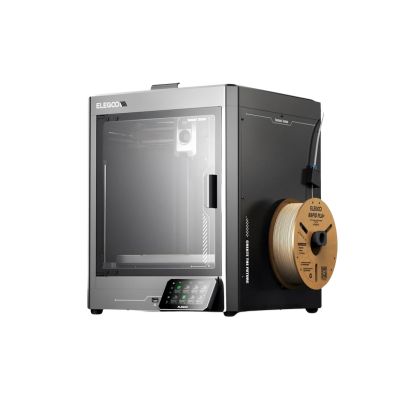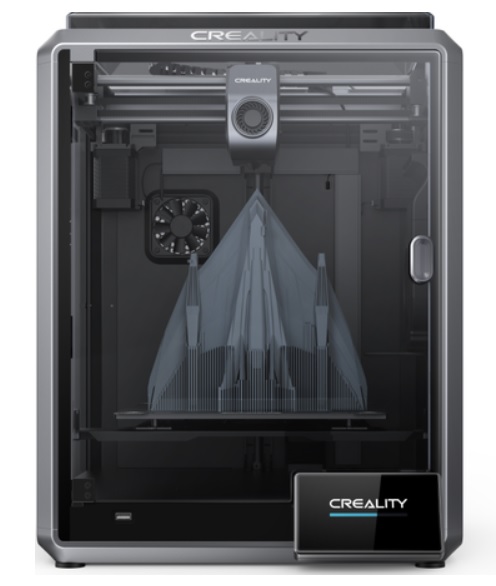Compare Centauri Carbon vs K1
Comparison between the best 3D printers
Choose the best 3D printer at the best price. The cheapest 3D printers are here.
Buy a 3D printer here with 3D Fila.
 |
 |
|
| Model | Centauri Carbon |
K1[BUY K1] |
| Printing Material | Filament | Filament |
| Buy Filament for Elegoo Centauri Carbon | Buy Filament forCreality 3D K1 | |
| Estimated price | $500,00 | $399,00 |
| Manufacturer | Elegoo | Creality 3D |
| Release Year | 2025 | 2023 |
| Print Volume [mm] | 256x256x256 | 220x220x250 |
| Printer Size [mm] | 500x500x600 | 355x355x480 |
| Weight [kg] | 17,5 | 12,5 |
| Power Loss Recovery | YES | YES |
| Enclosed printer | YES | YES |
| Bed Leveling | Automatic | Automatic |
| Filament End Sensor | YES | YES |
| Bed type | Heated | Heated |
| Power supply system | Direct Drive | Direct Drive |
| Standard nozzle | 0,4 | 0,4 |
| Maximum Nozzle Temperature [°C] | 300 | 300 |
| Maximum Bed Temperature [°C] | 110 | 120 |
| Maximum printing speed [mm/s] | 500 | 600 |
| Filament holder | YES | YES |
| Camera for supervision | YES | YES |
| Recommended filaments | PLA, PETG, ABS, ASA, TPU, NYLON, CARBON FIBER | ABS, PLA, PETG, PET, TPU, PA, ABS, ASA, PC, PLA-CF, PA-CF, PET-CF |
| Recommended slicers | Elegoo Slicer, Orca Slicer | Creality Print; Cura, Simplify3D e PrusaSlicer |
| Maximum Resolution [mm] | 0,1 | 0,1 |
| Processor | ||
| Display | Touchscreen 4,3'' | Display touchscreen 4,3'' |
| Power Supply | 350 W | 110/220V / 350W |
| Connectivity | WiFi, SD, USB | Ethernet / USB / Wi-Fi |
| Operating systems | Windows, Linux e Macbook | Windows, Mac, Linux |
| Date of registration in the system | 2025-02-10 | 2023-04-17 |
| Release date | 2025 | 2023 |
| Extra features | The Elegoo Centauri Carbon is a CoreXY 3D printer with an enclosed structure, direct drive extruder, and hardened steel components for abrasive materials. It features automatic bed leveling, a touchscreen, a filament cutting system, and an elongated nozzle designed to reduce clogs. It offers Wi-Fi connectivity for remote file transfer and runs on a Klipper-based firmware, providing advanced control and precise adjustments. | The K1 is an extremely fast FDM 3D printer, reaching 600mm/s, 12 times faster than standard models. Equipped with a Core XY system and lightweight print head, it offers energy efficiency and high print quality. It stands out for its dual-gear extruder and quickly heated hotend, as well as dual cooling to prevent warping. Its robust structure ensures stability at high speed, with optimized software to speed up the printing process. |
| Support for multiple colors and materials (AMS and CFS) | NO | NO |
Notes * |
||
| Cost-benefit | 8 / 10 | 7 / 10 |
| Hardware | 5.4 / 10 | 4.2 / 10 |
| Tela | . | . |
| Print volume | 4 / 10 | 3 / 10 |
| Performance | 4 / 10 | 5 / 10 |
| [BUY K1] |
Conclusion |
| In comparing the Elegoo Centauri Carbon and the Creality 3D K1, several factors emerge that cater to different user needs and preferences. The **Elegoo Centauri Carbon** stands out with its larger print volume, making it suitable for users looking to create bigger projects. Its advanced features, such as hardened steel components for abrasive materials and a unique nozzle design, enhance its capability for intricate prints. Additionally, the automatic bed leveling and touchscreen interface contribute to ease of use, particularly for beginners or those who prefer streamlined operations. Though it is priced slightly higher, the added size and robust construction make it a worthwhile investment for serious hobbyists or professionals who prioritize durability and capability. On the other hand, the **Creality 3D K1** offers impressive speed, with its capability to print at a maximum speed that significantly surpasses traditional models. This can be especially appealing for users who need to produce prototypes or models quickly. The K1 also incorporates user-friendly features such as dual cooling to mitigate warping and a lightweight print head, enhancing its efficiency during operation. While its build volume is smaller, it provides a strong overall performance at a more accessible price point, making it a compelling choice for casual users or those new to 3D printing. Both models include essential functionalities like automatic bed leveling, a heated bed, and various filament compatibility which ensures good results across common materials. Ultimately, the decision between the two will depend on the user's specific needs: larger print sizes and robust construction for the Centauri Carbon versus speed and cost effectiveness for the K1. Each printer offers a favorable cost-benefit ratio within its respective category, catering to a diverse audience in the 3D printing community. |

